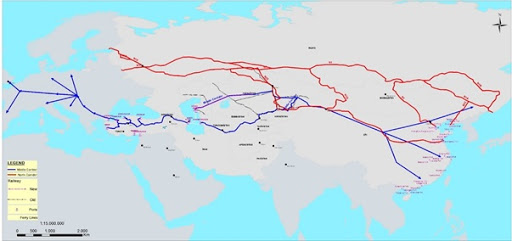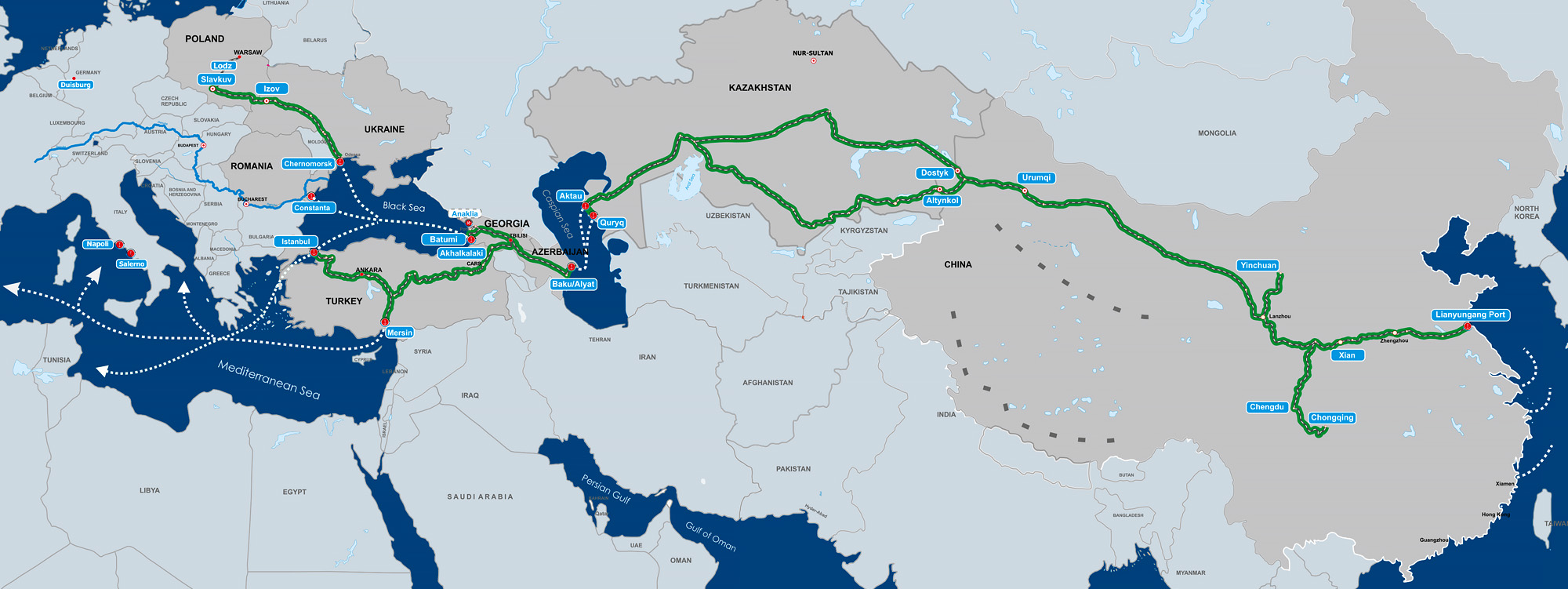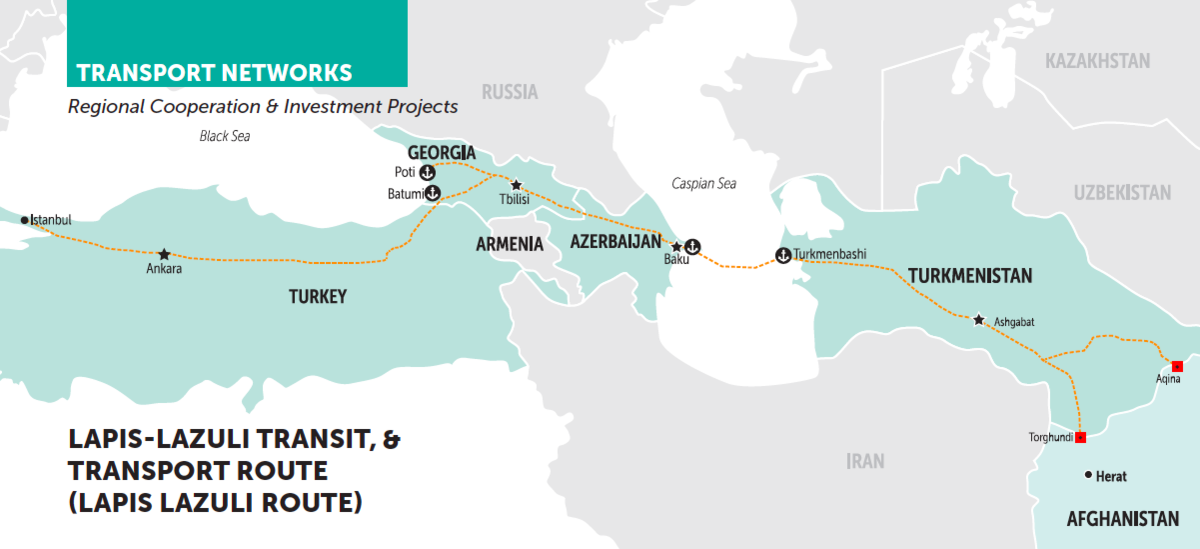By: Cavid Veliyev
82-container train cross the BTK Railroad on April 19, 2020 (Source: Business Turkmenistan)
Following the large coronavirus outbreak in Iran, neighboring countries quickly closed their borders with the Islamic Republic. More than a thousand Turkish trucks carrying goods to Central Asia found themselves stuck at checkpoints due to the closure of the Iran-Turkey and Iran-Turkmenistan borders (Daily Sabah, March 4). As a result, Ankara redirected its cargo trucks to the so-called “Middle Corridor,” a trade route connecting Turkey to Central Asia via Georgia, Azerbaijan and the Caspian Sea. The government of Turkey additionally increased the transit capacities of the Sarp, Turkgozu and Çıldır-Aktaş border gates (crossings) to Georgia. On April 10, during a video summit of the Turkic Council—a multilateral organization of Turkic-speaking states—that was held under the auspices of Azerbaijan’s President Ilham Aliyev, Turkish President Recep Tayyib Erdoğan pointedly underlined the importance of the Middle Corridor.
While the COVID-19 pandemic has negatively affected most international trade and transportation, it has also created new opportunities for some emerging routes. Until recent years, maritime shipping lanes and trade routes across Russia and Iran have connected Europe and Asia. Now, however, the Middle Corridor, through Turkey, Georgia, Azerbaijan and the Caspian Sea, is quickly becoming the shortest trade corridor between East and West. Map of the Middle Corridor (in blue) (Source: mfa.gov.tr)
Map of the Middle Corridor (in blue) (Source: mfa.gov.tr)
 Map of the Middle Corridor (in blue) (Source: mfa.gov.tr)
Map of the Middle Corridor (in blue) (Source: mfa.gov.tr)
Currently, Iran and Russia are the main export routes to Central Asia for Turkey. Approximately 30,000 trucks annually use the Iranian route, while another 9,000 trucks traverse Russia to reach the region. Past political disputes among these three countries, however, have created problems for Turkish truckers. In 2014, for example, Iran and Turkey were embroiled in a transit fee dispute (Financial Tribune, October 19, 2014). And, in 2015, after the downing of a Russian jet by Turkish F-16s near the Syrian border, Turkish trucks faced additional hurdles due to intensified Russian customs checks (Hurriyet Daily, November 26, 2015). These past developments and today’s COVID-19 crisis have highlighted Turkey’s need for alternative trading routes.
In recent years, regional players signed a series of key agreements designed to improve the infrastructure capacity of the Middle Corridor and to bolster transportation activities among the partner countries. The opening of the Baku–Tbilisi–Kars (BTK) Railroad, in 2017, was a crucial event in this regard, which strengthened the potential of the encompassing transit route. Last February, Turkish Trade Minister Ruhsar Pekcan remarked that her country may be able to increase the daily passage of rail cars traversing the BTK Railroad from 40 to 60 as well as further extend this line (Railly News, February 28). On April 19, a 940-meter freight train (the longest to have ever operated on the BTK), carrying 82 containers, departed from Turkey for Central Asia, with planned stops in Azerbaijan, Kazakhstan and Turkmenistan before reaching its final destination in Uzbekistan. So while many countries face a wide spectrum of difficulties because of the coronavirus pandemic, railway transportation appears to have gained new momentum in the region (Business Turkmenistan, April 21).
The emergence of several new transportation corridors traversing the Caspian Sea have increased the feasibility of the Middle Corridor itself. Two Trans-Caspian transportation corridors are currently under construction: the Trans-Caspian International Transportation Route (TITR—which connects Kazakhstan, Azerbaijan, Georgia and Turkey) and the Lapis-Lazuli Corridor (encompassing Afghanistan, Turkmenistan, Azerbaijan, Georgia and Turkey). Both routes play a key role in connecting the land-locked regional countries to the world market, especially in Europe. These new intermodal routes will also help participating countries integrate their transportation infrastructure, foster economic cooperation and increase intra-regional trade.
The TITR was established in February 2014, with the participation of the governments of Azerbaijan, Kazakhstan and Georgia. Turkey, Ukraine, Romania and Poland later joined the association as well. At present, this route extends from the Chinese-Kazakhstani border to European countries, passing through Kazakhstan, the Caspian Sea, Azerbaijan and Georgia, utilizing a “single window” principle (an administrative efficiency mechanism in which there is a single entry point for all import, export and transit-related regulatory requirements) (Azernews, January 18). In 2019, container traffic between Baku and Aktau—the two main ports of the TITR—increased by 71 percent (Ady Express, January 21). In January 2020, the first meeting of the TITR working group took place in Almaty, Kazakhstan. Officially called the “General Meeting of the Association of Legal Entities of the International Association of the Trans-Caspian International Transport Route,” the two-day event included delegates from shipping, railway services, port and logistics companies from Azerbaijan, Turkey, Kazakhstan, Georgia, Ukraine, Georgia, Romania and China. The discussions focused on how to attract more use of the route, and to enhance the efficiency, effectiveness, and interconnection of the associated transport (Asco.az , January 21). Trans-Caspian International Transportation Route (Source: middlecorridor.com)
Trans-Caspian International Transportation Route (Source: middlecorridor.com)
 Trans-Caspian International Transportation Route (Source: middlecorridor.com)
Trans-Caspian International Transportation Route (Source: middlecorridor.com)
A formal agreement on the Lapis-Lazuli Corridor was signed in October 2017, by Afghanistan, Turkmenistan, Azerbaijan, Georgia and Turkey. The corridor’s opening ceremony took place in Herat, the western province of Afghanistan, on December 13, 2018. On the same day, a test run involving nine heavy vehicles was launched, which reached Turkey in 15 days (Orient.tm, April 15). The simplification and facilitation of customs procedures along the Lapis-Lazuli Corridor will increase traffic at the ports along the route. In the meantime, there is potential for increased economic exchange between Afghanistan and Azerbaijan. Trade with and via Azerbaijan would help the war-torn South Asian country benefit from its strategic location, while also potentially contributing to Afghanistan’s stronger regional integration. (Source: Wikimedia Commons)
(Source: Wikimedia Commons)
 (Source: Wikimedia Commons)
(Source: Wikimedia Commons)
Cooperation between Azerbaijan and Turkmenistan has steadily grown over the past three years, especially with regard to Trans-Caspian transportation corridors. In 2017, Turkmenistani President of Gurbanguly Berdimuhamedov visited Azerbaijan and a major portion of his talks with President Aliyev was devoted to transportation issues. During that visit, Azerbaijan and Turkmenistan signed “The Declaration on Strategic Cooperation,” supporting the Lapis-Lazuli Corridor and the TITR. Presidents Aliyev and Berdimuhamedov visited each other’s countries in 2018 and 2020, respectively, and signed additional agreements on transportation via the Caspian Sea in order to simplify mutual border crossing procedures as well as develop infrastructure between the two states.
Efforts by regional countries like Azerbaijan, Turkey, Kazakhstan and Turkmenistan have helped develop the Middle Corridor into a functional trade route. Today, the Middle Corridor is fast becoming the safest and shortest trade route between Europe and Asia. This route, which is supported by the United States and the European Union, also encourages greater integration of the regional countries as well as the development of trade relations between landlocked countries, such as Azerbaijan, Kazakhstan, Turkmenistan, Uzbekistan and Afghanistan—finally more directly connecting them to the global market.
No comments:
Post a Comment